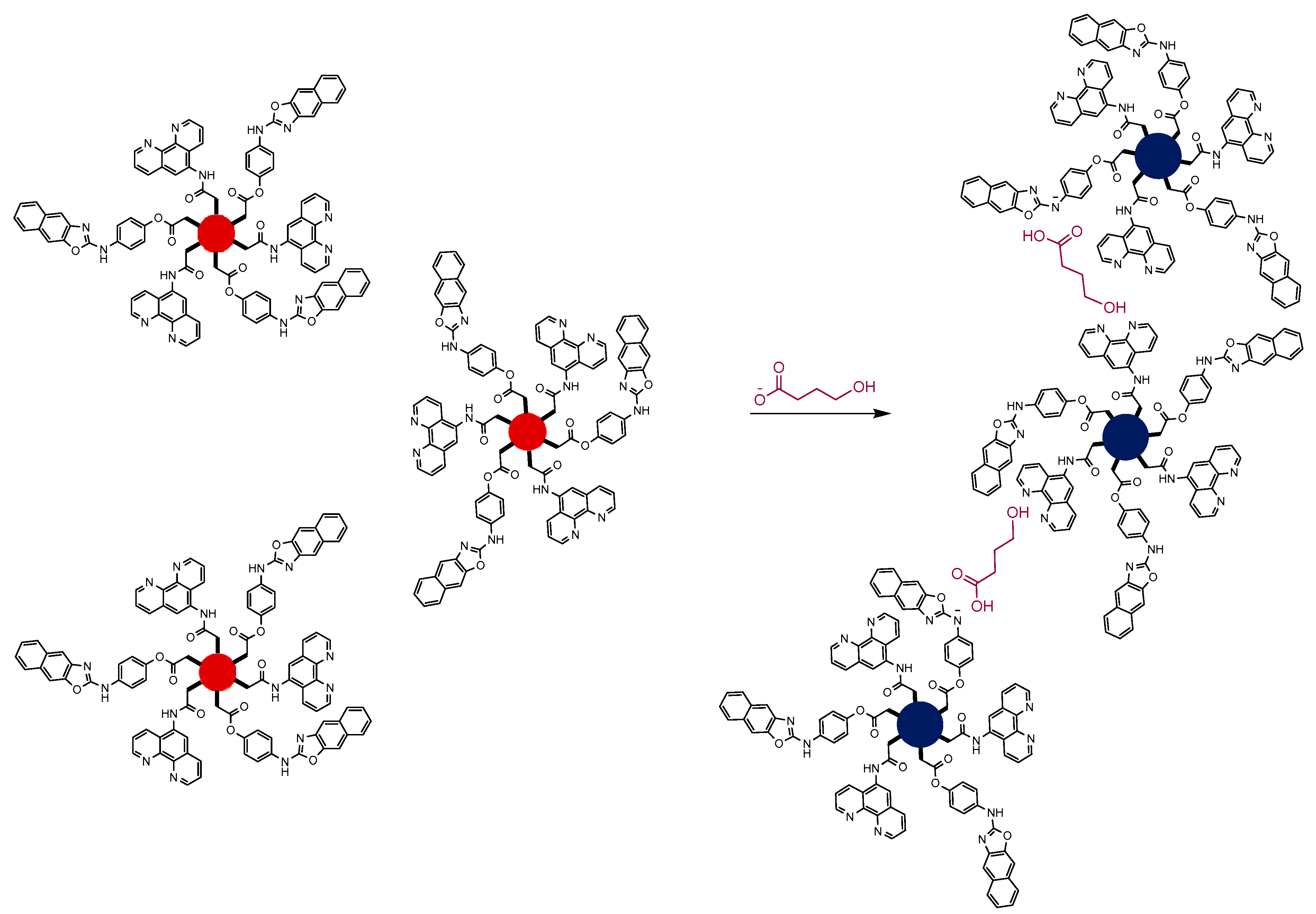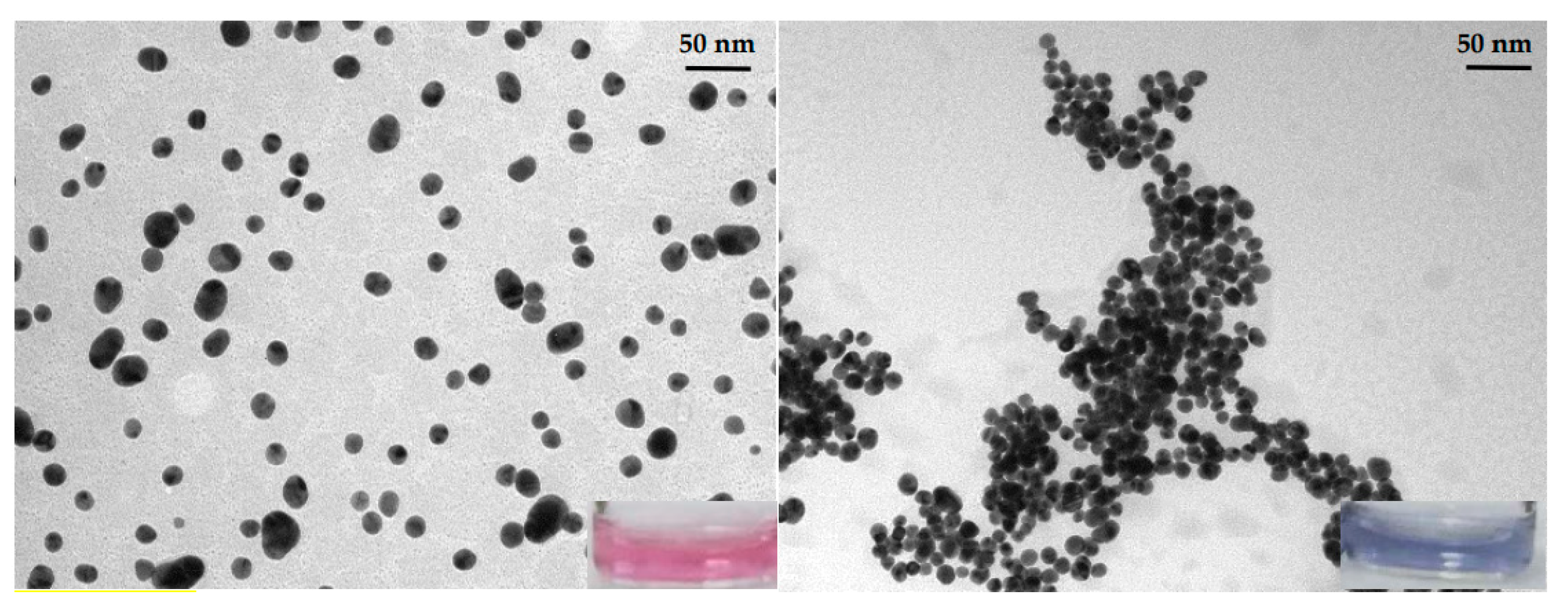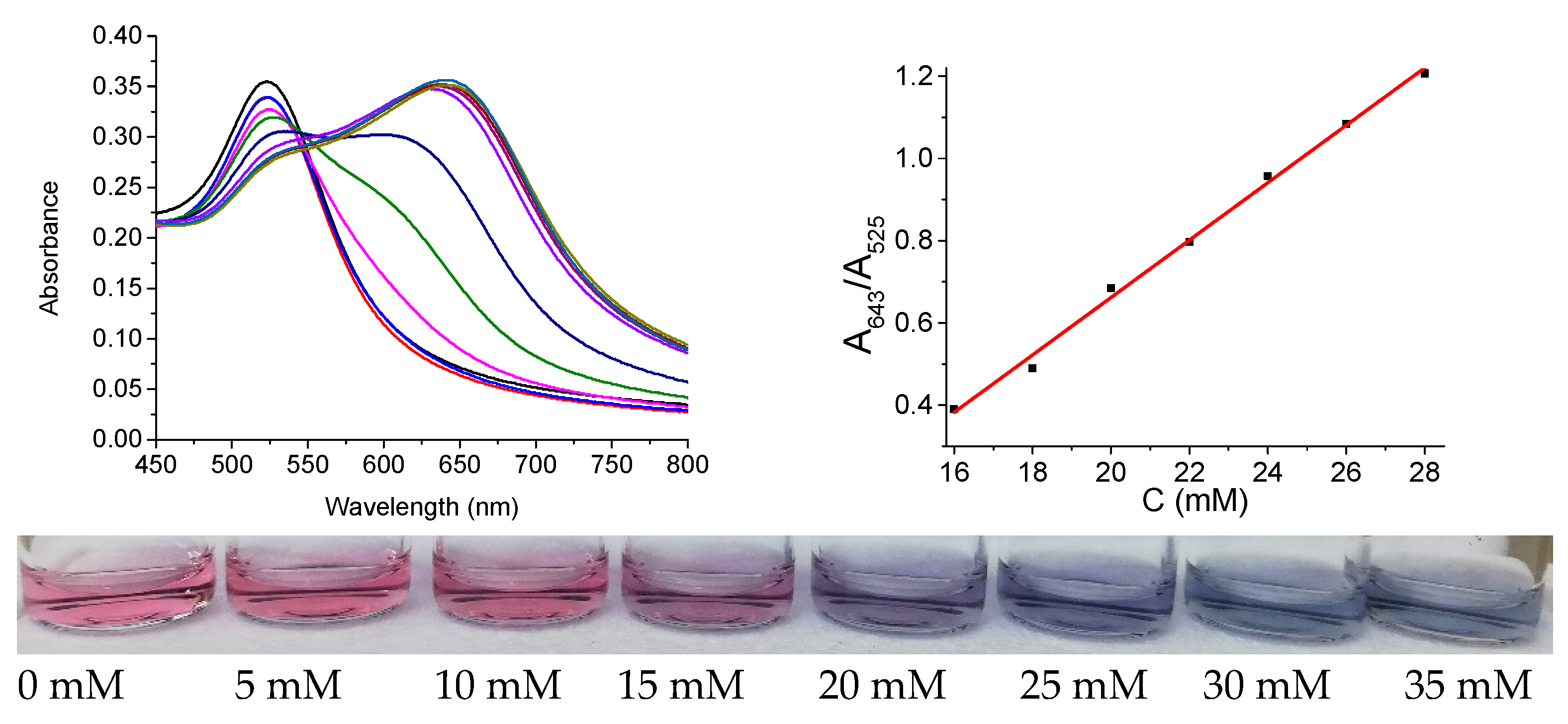Bifunctionalized Gold Nanoparticles for the Colorimetric Detection of the Drug γ-Hydroxybutyric Acid (GHB) in Beverages
Abstract
:1. Introduction
2. Materials and Methods
2.1. Synthesis of the Ligands
2.1.1. Synthesis of 3
2.1.2. Synthesis of 4
2.1.3. Synthesis of 5
2.1.4. Synthesis of L1
2.1.5. Synthesis of L2
2.2. Synthesis of the Functionalized Gold Nanoparticles (AuNPs)
2.2.1. Synthesis of Citrate-Capped Gold Nanoparticles (Citrate-GNPs)
2.2.2. Synthesis of GNP1
2.2.3. Exchange of Buffer
2.3. UV–Vis Measurements
2.3.1. GHB Titration
2.3.2. AcONa/EtOH vs. GHB
2.3.3. Interferent Measurements
2.4. Real Samples
3. Results and Discussion
3.1. AuNPs Preparation
3.2. Sensing Experiments
4. Conclusions
Supplementary Materials
Author Contributions
Funding
Institutional Review Board Statement
Informed Consent Statement
Data Availability Statement
Acknowledgments
Conflicts of Interest
References
- Olszewski, D. Sexual assaults facilitated by drugs or alcohol. Drugs Educ. Prev. Policy 2019, 16, 39–52. [Google Scholar] [CrossRef]
- Nemeth, Z.; Kun, B.; Demetrovics, Z. Gamma-hydroxybutyrate (GHB): An emerging substance of abuse. J. Psychopharmacol. 2010, 24, 1281–1287. [Google Scholar]
- Busardò, F.P.; Jones, A.W. GHB Pharmacology and Toxicology: Acute Intoxication, Concentrations in Blood and Urine in Forensic Cases and Treatment of the Withdrawal Syndrome. Curr. Neuropharmacol. 2015, 13, 47–70. [Google Scholar] [CrossRef] [Green Version]
- Davis, K.E.; Hickey, L.D.; Goodpaster, J.V. Detection of [n.611]-hydroxybutyric acid (GHB) and [n.611]-butyrolactone (GBL) in alcoholic beverages via total vaporization solid-phase microextraction (TV-SPME) and gas chromatography-mass spectrometry. J. Forensic Sci. 2021, 66, 846–853. [Google Scholar] [CrossRef] [PubMed]
- Jin, S.; Ning, X.; Cao, J.; Wang, Y. Simultaneous Quantification of γ-Hydroxybutyrate, γ-Butyrolactone, and 1,4-Butanediol in Four Kinds of Beverages. Int. J. Anal. Chem. 2020, 8837743. [Google Scholar]
- Jin, S.; Ning, X.; Cao, J.; Wang, Y. Food safety risk assessment of gamma-butyrolactone transformation into dangerous gamma-hydroxybutyric acid in beverages by quantitative 13Carbon-nuclear magnetic resonance technique. J. Food Qual. 2020, 43, 8846214. [Google Scholar]
- Garrido, E.; Pla, L.; Lozano-Torres, B.; El Sayed, S.; Martinez-Mañez, R.; Sancenon, F. Chromogenic and Fluorogenic Probes for the Detection of Illicit Drugs. Chem. Open 2018, 7, 401–428. [Google Scholar] [CrossRef] [PubMed]
- Zhai, D.; Qiao, Y.; Tan, E.; Xu, W.; Chang, Y.-T. Development of a fluorescent sensor for illicit date rape drug GHB. Chem. Commun. 2014, 50, 2904–2906. [Google Scholar] [CrossRef]
- Zhai, D.; Agrawalla, B.K.; Eng, P.S.F.; Lee, S.-C.; Xua, W.; Chang, Y.-T. Development of a fluorescent sensor for an illicit date rape drug—GBL. Chem Commun. 2013, 49, 6170–6172. [Google Scholar] [CrossRef] [Green Version]
- Wang, W.; Dong, Z.-Z.; Yang, G.; Leung, C.-H.; Lin, S.; Ma, D.-L. A long-lived iridium(iii) chemosensor for the real-time detection of GHB. J. Mat. Chem. B 2017, 8, 2736–2742. [Google Scholar] [CrossRef]
- Bravo, D.; Harris, D.; Parsons, S. Reliable, sensitive, rapid and quantitative enzyme-based assay for gamma-hydroxybutyric acid (GHB). J. Forensic Sci. 2004, 49, 379–387. [Google Scholar] [CrossRef] [PubMed]
- Baumes, L.A.; Sogo, M.B.; Montes-Navajas, P.; Corma, A.; Garcia, H. A Colorimetric Sensor Array for the Detection of the Date-Rape Drug γ-Hydroxybutyric Acid (GHB): A Supramolecular Approach. Chem. Eur. J. 2010, 16, 4489–4495. [Google Scholar] [CrossRef]
- Hu, M.; Han, Q.; Xing, B. Metallic nanoparticle-enabled sensing of a drug-of-abuse: An attempt at forensic application. ChemBioChem 2020, 21, 2512–2517. [Google Scholar] [CrossRef]
- Mayer†, K.M.; Hafner, J.H. Localized Surface Plasmon Resonance Sensors. Chem. Rev. 2011, 111, 3828–3857. [Google Scholar] [CrossRef] [PubMed]
- Priyadarshinia, E.; Pradhana, N. Gold nanoparticles as efficient sensors in colorimetric detection oftoxic metal ions: A review. Sens. Actuators B 2017, 238, 888–902. [Google Scholar] [CrossRef]
- Godoy-Reyes, T.M.; Costero, A.M.; Gaviña, P.; Martínez-Máñez, R.; Sancenón, F. Colorimetric detection of normetanephrine, a pheochromocytoma biomarker, using bifunctionalised gold nanoparticles. Anal. Chim. Acta 2019, 1056, 146–152. [Google Scholar] [CrossRef]
- Martí, A.; Costero, A.M.; Gaviña, P.; Parra, M. Selective colorimetric NO(g) detection based on the use of modified gold nanoparticles using click Chemistry. Chem. Commun. 2015, 51, 3077–3079. [Google Scholar] [CrossRef]
- Rodríguez-Nuévalos, S.; Costero, A.M.; Arroyo, P.; Sáez, J.A.; Parra, M.; Sancenón, F.; Martínez-Máñez, R. Protection against chemical submission: Naked-eye detection of γ-hydroxybutyric acid (GHB) in soft drinks and alcoholic beverages. Chem. Commun. 2020, 56, 12600–12603. [Google Scholar] [CrossRef]
- Mazik, M.; Hartmann, A.; Jones, P.G. Highly Effective Recognition of Carbohydrates by Phenanthroline-Based Receptors: α- versus β-Anomer Binding Preference. Chem. Eur. J. 2009, 15, 9147–9159. [Google Scholar] [CrossRef]
- Talwelkar, M.; Pedireddi, V.R. -B(OH)2 versus -OH in supramolecular synthesis: Molecular complexes of 4-hydroxyphenylboronic acid with aza-donor compounds. Tetrahedron Lett. 2010, 51, 6901–6905. [Google Scholar] [CrossRef]
- Kirby, I.L.; Pitak, M.B.; Wilson, C.; Galea, P.A.; Coles, S.J. Electron density distribution studies as a tool to explore the behaviour of thiourea-based anion receptors. CrystEngComm 2015, 17, 2815–2826. [Google Scholar] [CrossRef]
- Yadav, V.K.; Srivastava, V.P.; Yadav, L.D.S. Iodide catalyzed synthesis of 2-aminobenzoxazoles via oxidative cyclodesulfurization of phenolic thioureas with hydrogen peroxide. Tetrahedron Lett. 2018, 59, 252–255. [Google Scholar] [CrossRef]
- Weinig, H.-G.; Krauss, R.; Seidock, M.; Bendig, J.; Koert, U. Molecular Signal Transduction by Conformational Transmission: Use of Tetrasubstituted Perhydroanthracenes as Transducers. Chem. Eur. J. 2001, 7, 2075–2088. [Google Scholar] [CrossRef]
- Zhao, P.; Li, N.; Astruc, D. State of the art in gold nanoparticle synthesis. Coord. Chem. Rev. 2013, 257, 638–665. [Google Scholar] [CrossRef]
- Liu, X.; Atwater, M.; Wang, J.; Huo, Q. Extinction coefficient of gold nanoparticles with different sizes and different capping ligands. Colloids Surf. B Biointerfaces 2007, 58, 3–7. [Google Scholar] [CrossRef]
- Royo-Isaach, J.; Magrané, M.; Vilà, R.; Capdevila, M.E. El «éxtasis líquido» (GHB): ¿una droga de uso recreativo? Clínica biopsicosocial del consumidor y algunas propuestas terapéuticas. Aten Primaria 2004, 33, 516–520. [Google Scholar] [CrossRef] [Green Version]
- Kregiel, D. Health Safety of Soft Drinks: Contents, Containers, and Microorganisms. BioMed Res. Int. 2015, 2015, 128697. [Google Scholar] [CrossRef] [PubMed] [Green Version]







| Material | Size (nm) TEM Images | Size (nm) DLS | Z Potential (mV) |
|---|---|---|---|
| Citrate–GNP | -------- | 24.2 ± 1.6 | −29.2 ± 0.9 |
| GNP1 | 18 ± 2 | 25.2 ± 0.3 | −37 ± 2 |
Publisher’s Note: MDPI stays neutral with regard to jurisdictional claims in published maps and institutional affiliations. |
© 2021 by the authors. Licensee MDPI, Basel, Switzerland. This article is an open access article distributed under the terms and conditions of the Creative Commons Attribution (CC BY) license (https://creativecommons.org/licenses/by/4.0/).
Share and Cite
Rodríguez-Nuévalos, S.; Costero, A.M.; Gil, S.; Parra, M.; Gaviña, P. Bifunctionalized Gold Nanoparticles for the Colorimetric Detection of the Drug γ-Hydroxybutyric Acid (GHB) in Beverages. Chemosensors 2021, 9, 160. https://doi.org/10.3390/chemosensors9070160
Rodríguez-Nuévalos S, Costero AM, Gil S, Parra M, Gaviña P. Bifunctionalized Gold Nanoparticles for the Colorimetric Detection of the Drug γ-Hydroxybutyric Acid (GHB) in Beverages. Chemosensors. 2021; 9(7):160. https://doi.org/10.3390/chemosensors9070160
Chicago/Turabian StyleRodríguez-Nuévalos, Silvia, Ana M. Costero, Salvador Gil, Margarita Parra, and Pablo Gaviña. 2021. "Bifunctionalized Gold Nanoparticles for the Colorimetric Detection of the Drug γ-Hydroxybutyric Acid (GHB) in Beverages" Chemosensors 9, no. 7: 160. https://doi.org/10.3390/chemosensors9070160






